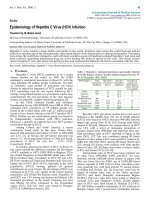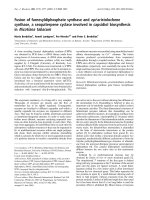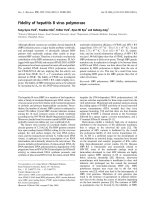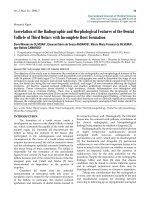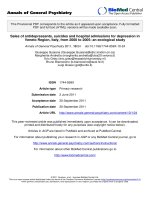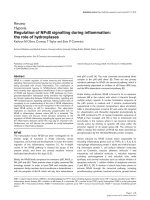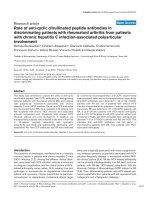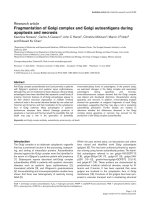Báo cáo y học: "Seroprevalence of hepatitis B and C virus in HIV-1 and HIV-2 infected Gambians" pps
Bạn đang xem bản rút gọn của tài liệu. Xem và tải ngay bản đầy đủ của tài liệu tại đây (278.13 KB, 9 trang )
RESEARC H Open Access
Seroprevalence of hepatitis B and C virus in HIV-1
and HIV-2 infected Gambians
Modou Jobarteh
1
, Marine Malfroy
1,4
, Ingrid Peterson
1
, Adam Jeng
1
, Ramu Sarge-Njie
1
, Abraham Alabi
1,5
,
Kevin Peterson
1
, Matt Cotten
1
, Andrew Hall
2
, Sarah Rowland-Jones
1,6
, Hilton Whittle
1
, Richard Tedder
3
, Assan Jaye
1
,
Maimuna Mendy
1*
Abstract
Background: The prevalence of HIV/hepatitis co-infection in sub-Saharan Africa is not well documented, while
both HIV and HBV are endemic in this area.
Objective: The aim of this study is to determine the seroprevalence of HBV and HCV virus in HIV-infected subjects
in the Gambia.
Methods: Plasma samples from HIV infected patients (190 individuals with clinically defined AIDS and 382
individuals without AIDS) were tested retrospectively for the presence of HBV sero-markers and for serum HBV
DNA, screened for HCV infection by testing for anti-HCV antibody and HCV RNA.
Results: HBsAg prevalence in HIV-positive individuals is 12.2%. HIV/HBV co-infected individuals with CD4 count of
<200 cells uL-1 have a higher HBV DNA viral load than patients with higher CD4 count (log 4.0 vs. log 2.0 DNA
copies/ml, p < 0.05). Males (OR = 1.8, 95% CI: 1.0 , 3.2) were more likely to be HBsAg positive than female. HCV
seroprevalence was 0.9% in HIV-positive individuals.
Conclusion: The prevalence of HBsAg carriage in HIV- infected Gambians is similar to that obtained in the general
population. However co-infected individuals with reduced CD4 levels, indicative of AIDS had higher prevalence of
HBeAg retention and elevated HBV DNA levels compared to non-AIDS patients with higher CD4 count.
Background
It is estimated that 350 million people world -wide are
chronically infected with hepatitis B virus (HBV) and
over 500,000 people die annually from HBV-related
causes [1,2]. HBV Carrier s are at a high risk of develop-
ing cirrhotic liver disease and hepatocellular carcinoma
(HCC), the most frequent cause of cancer morbidity and
mortality worldwide [3]. Hepatitis C virus (HCV) pro-
duces a chronic infection in up to 80% of infected indi-
viduals. Like HBV, the virus is a major cause of severe
liver fibrosis, cirrhosis and HCC [4,5]. Approximately
170 million people are infected with HCV worldwide
and over three million new infections occur each year
[6]. The prevalence rates in sub-Saharan Africa are
highly variable, ranging from 0-40% with Cameroon
having a p revalence of 13% [7] and 16% reporte d in
pregnant women in Malawi [8,9].
Although HBV and HCV are well documented for the
general Gambian population [10-13], there is limited
data on HBV and HCV seroprevalence in Human
Immunodeficiency Virus (HIV)-infected Gambians.
HBV, HCV and HIV infections are important causes of
infectious diseases worldwide. HIV affects more than
33.4 million people worldwide, o f which 22.7 million
live in sub-Saharan Africa a nd 2.7 million new HIV
infections were reported in 20 08 [14]. In West Africa,
Acquired Immunodeficiency Synd rome (AIDS) is caused
by both HIV-1 and the related but generally less patho-
genic HIV-2 [15].
The prevalence of H IV-1 reported in Senegal, The
Gambia and Guinea Bissau is between 0.5-5.0% [16] and
that of HIV-2 i s between 3.3 to 8.3% [17,18]. However,
recent studies in Bissa u have reported a decrease in
* Correspondence:
1
Medical Research Council, Fajara, P O Box 273, Banjul, The Gambia
Full list of author information is available at the end of the article
Jobarteh et al. Virology Journal 2010, 7:230
/>© 2010 Jobarteh et al; licensee BioMed Central Ltd. This is an Open Access article distributed under the terms of the Creative
Commons Attribution License (http:/ /creativecommons.org/licenses/by/2.0), whi ch permits unrestricted use, distribution, and
reproduction in any medium, provided the original work is properly cited.
HIV-2 from 8.3% to 4.7% in a period of 17 yrs, whilst
HIV-1 is on the increase from 0.5% to 3.7% [19].
When both HBV and HIV co-infe ct a patient, the
mortality rate f rom chronic hepatitis B is increased
above that of either infection alone with a faster rate of
progression to liver cirrhosis and hepatocellular carci-
noma (HCC) [20-22]. Co-infected individuals have a
reduction of HBV surface antigen (HBsAg) seroconve r-
sion, higher levels of HBV DNA and often show reacti-
vation of HBV replication despite previous HBsAg
seroconversion [23].
In this era of rolling out Highly Active Antiretroviral
Therapy (HAART) it is important to document HIV-
HBV co-infection in regions with high chro nic hepatitis
B endemicity and HIV i nfection rates. In the U.S. liver
disease, due to c hronic HBV and/or HCV infection, has
become one of the leading causes of mortality among
people with HIV infection, despite the low preva lence in
the general population. Moreover, some ARVs, including
lamivudine (3TC) common ly used in first line ART,
possess anti-HBV activity. When these drugs are used as
monotherapy for HBV treatment, this will create the
potential for inducing HBV viral drug resistance muta-
tions and selection of viral populations that may escape
current HBV vaccines.
Theaimofthisstudyistodeterminetheprevalence
of HBV and HCV in HIV infected subjects and to com-
pare the level of HBV DNA, a marker of HBV replica-
tion in AIDS vs. non-AIDS patients.
Results
Demographic data and HIV status of subjects in the study
The demography data is presented in Tables 1 and 2.
The age ranges of the subjects were 7 months -71 ye ars
(median = 35 yrs) for AIDS patients and 17 - 93 yrs
(median = 31 years) for non-AIDS subjects. The propor-
tions o f females infected with HIV were 61% in the
AIDS and 80% in the non-AIDS co hort. Overall, HIV-1,
HIV-2 and HIV-Dual infections accounted for 52%, 43%
and 5% of HIV infections. However, HIV-1 infection
made up 75% of the HIV infections in the AIDS cohort,
compared to only 41% in the non-AIDS. Median CD4
count at baseline was signif icantly lower in the AIDS
patients at pre-treatment time point compared to the
non-AIDS (p-values in each HIV-strata <0.001, analysis
not shown). The CD4 values did not vary significantly
across HIV-type in either the AIDS patients (pre-treat-
ment time point ) or non-AIDS groups (AIDS cohort,
p-value = 0.55; non-AIDS cohort, p-value = 0.36; analy-
sisnotshown).IntheAIDScohort,medianHIVviral
loads before the start of treatment w ere not different
between HIV type (5.1 log
10
copies mL-1 for HIV-1 and
4.8 l
og10
copies mL-1 for HIV-2 (p-value = 0.28).
HBV infection in HIV infected Gambians
Overall 78.1% (447 out of 572) of HIV positive indivi-
duals tested e ither positive for HBsAg or anti-HBc.
Seventy samples tested positive for HBsAg, giving an
overall prevalence of chronic HBV of 12.2% (95% CI
[0.09 - 0.15]) (Table 3). HBsAg prevalence did n ot vary
significantly between AIDS and non-AIDS groups
(15.7% vs. 11%) (p-value = 0.29, analysis not shown).
Additionally, univariate analysis showed no significant
differences in HBsAg prevalence by gender, age group,
HIV type or baseline CD4 cell count. However a logistic
model which regressed HBsAg on age, sex, HIV-type
and immune status revealed that HIV infected males
were significantly more likely to be HBsAg positive
(OR = 1.8, 95% Confidence Interval [CI]: 1.0, 3.2) than
women, as were younger people (10-24 yrs) compared
to adults (OR [per year] = 1.9. 95% CI: 0.9, 1.0) (Logistic
analysis is not shown in the table).
Overall, 26.1% (95% CI [16.2. 36.5]) of chronic carriers
were HBeAg positive, this did not differ by clinical sta-
tus; i.e. AIDS vs. non-AIDS (p-value = 0.17) but HBeA g
positivity was associated with HIV type as 14.8% (4/27),
30% (12/40) and 100% (2/2) HIV-2, HIV-1 and Duals
respectively tested positive for HBeAg (p-value = 0.03).
The overall prevalence of anti-HBc antibody in the
502 HBsAg negative HIV-infected individuals was 79.1
(95% CI [79.0, 86.1], the marker showed an increase
with age; however this trend was not statistically signifi-
cant . In multivariable logistic analysis, onl y m ale gender
and HIV type were significantly associated with HBcAb
positivity. In the model, HBcAb prevalence was
Table 1 Baseline characteristics of HIV-infected patients
at MRC Genito-Urinary Clinic, the Gambia
AIDS patients
(pre-treatment time point)
Non-AIDS Total
Gender
1
N = 190 N = 382 N = 572
Male 74 (39.3) 77 (20.1) 151 (26.3)
Female 116 (60.7) 305 (79.8) 421 (73.6)
Age
1
0-9 years 27 (14.2) 0 (0.0) 27 (4.7)
10-24 years 10 (5.2) 84 (21.9) 94 (16.4)
25-34 years 30 (15.7) 183 (47.9) 213 (37.2)
35-44 years 72 (37.8) 62 (16.2) 134 (22.5)
45-93 years^ 51 (14.2) 53 (13.8) 104 (3.4)
HIV Status
1
HIV-1 142 (74.8) 157 (40.9) 299 (55.2)
HIV-2 29 (15.2) 215 (56.4) 244 (42.6)
Dual Infection 19 (10.0) 10 (2.6) 29 (5.0)
1
Number and percent are reported for gender, age, HIV status.
^
Maximum age in AIDS was 71 years; maximum age in non-AIDS was 93
years
Jobarteh et al. Virology Journal 2010, 7:230
/>Page 2 of 9
significantly higher in men (OR = 2.2, 95% CI [1.2, 4.3])
(The logistic analysis is not shown).
Overall, twenty-five of seventy HBsAg positive indivi-
duals had detectable HBV DNA, 62% (18/29) of AIDS
and 17% (7/41) of the non-AIDS carriers (Tabl e 4) with
higher preval ence obse rved in H IV-1 and H IV-Dually
infected patients compared to HIV-2 (43.2% and 100%
vs. 20.8% respectively) (p-value 0.03). In paired t-tests
these differences were significant between HIV-1 and
HIV-2 and between HIV-2 and HIV-Dually infected
patients, b ut not between HIV-1 and HIV-Dual s (analy-
sis not shown). A higher proportion of men in the AIDS
group had detectable HBV DNA at pre treatment time
point than their women counterparts (83.3% v s. 40.0%)
(p-value 0.05), but this trend was not observed in the
non-AIDS group at the baseline time point.
CD4 levels in HBV-HIV co-infected individuals
CD4 counts were obtained for 184 out of 190 AIDS
patients at prior to ART including 29 HBsAg positive of
which 25 had CD4 counts (Table 3). The ind ividuals
were divided into two groups based on thei r CD4 count
(cut off < 200 cells μL-1). The prevalence of HBsAg
positivity was not associated with CD4 levels, with equal
proportion of HBsAg positive subjects repo rted in either
the low level or high level CD4 group (11/29 vs. 14/29)
(Table 3). Co-infected patients with low CD4 count
(< 200 cells μL-1) had a higher HBV DNA viral load
than patients with high CD4 count of (> 200 cells μL-1)
(2.5 × 10
4
vs. 2.8 × 10
2
DNA copies mL-1) (p < 0.05).
HCV infection in HIV infected Gambians
Two independent HCV antibody assays result in 19.4%
(37/190) in AIDS and 6.7% (26/382) in non-AIDS indivi-
duals testing positive for HCV (Table 5). However, con-
fir mato ry test using RIBA HCV 3.0 SIA detected on ly 2
(1.0%) positive samples from the AIDS and 5 (1.3%)
from the non-AIDS group, 56 samples were not con-
firmed by RIBA of which 5 showed indeterminate
results, The age of these 7 individuals ranged from 29 to
68 years and they were all negative for HBsAg (Table 6).
HCV RNA detection by RT-PCR was performed in
order to determine the prevalence of chronic HCV
infection. Using primers specific to the 5′UTR and NS5b
regions we ampli fied 251 bp an d 37 9 bp fragments
respectively. HCV RNA was detected in 4 (1- AIDS and
3-non-AIDS)outof7RIBAHCV3.0SIApositive
samples and in none of the 56 RIBA negative samples.
Genome sequence data from the 4 HCV RNA positive
samples were compared wit h sequences from the Gen-
Bank. Phylogenetic analysis on the Gambian HCV
sequences in comparison with the GenBank sequences
showed similarity with HCV genotype 2 sequences
AF037254, AF037239 and AF037253(data not shown).
Discussions
HIV-HBV Dual infection is not uncommon where both
diseases are endemic. We assessed the level and impact
of this co-infection among both AIDS and non-AIDS
patients. Comparing these infections provided an insight
into the role of co-infection in disease progression in
chronic HBV carriers [23].
The HBsAg prevalence detected in HIV infected indi-
viduals was 12.2% with 78.1% positivity for either
HBsAg or anti-HBc, which is comparable to the overall
levels obtained in children [10,11] and in controls from
a liver cancer case control study [12]. 62% of the chil-
dren were infected with HBV with between 17-36%
Table 2 Baseline HIV viral load and CD4 counts of HIV-
infected patients at MRC Genito-Urinary Clinic, the
Gambia
AIDS Non-AIDS Total
(pre-treatment) (baseline)
HIV-1 Infection N = 142 N = 157 N = 299
1
Viral Load (c mL-1) 1.27 × 10
5
(6.9 ×
10
5
)
––
1
CD4 Count
(cells μL-1)
*160 (220.0) *690.0
(510.0)
390.0
(600.0)
CD4 Count < 200 cells
μL-1
2
78 (56.9) 5 (3.2) 83 (28.3)
1
CD4 Percent 7 (9.0) 32.0 (8.0) 15.5 (24.0)
HIV-2 Infection N = 29 N = 215
1
Viral Load (c mL-1) 5.88 × 10
4
(3.5 ×
10
5
)
–
1
CD4 Count (cells μL-1) **140 (210.0) **649.0
(450.0)
600.0
(510.0)
2
CD4 Count < 200 cells
μL-1
17 (58.6) 9 (4.2) 26 (10.7)
1
CD4 Percent 10 (14.0) 34.0 (10.0) 33.0 (11.0)
HIV-1 and HIV-2 N = 19 N = 10
1
HIV-1 Viral Load
(c mL-1)
1.60 × 10
5
(3.4
x10
5
)
–
1
HIV-2 Viral Load
(c mL-1)
100 (5.8 × 10
3
) –
1
CD4 Count 140.0 (130.0) **720.0
(282.0)
180.0
(488.0)
2
CD4 Count < 200 cells
μL-1
14.0 (77.8) 0 (0) 14 (51.9)
1
CD4 Percent 8.0 (6.0) 33 (6.0) 9.0 (8.0)
ALT for all HIV +
1
ALT Level ***20.0 (14.0) ***14.0
(10.5)
16.0 (12.0)
1
Abnormal (ALT > 46) 15.0 (7.6) 7.0 (2.9) 22 (5.1)
1
Median values are reported for HIV viral load, CD4 count, CD4 percent, ALT
level. HIV viral load was not measured in non-AIDS. Viral load units are copies
mL-1 (c mL-1).
2
Number and percent are reported for CD4 count <200 and
abnormal ALT. *10 HIV-1 (9 AIDS, 1 non-AIDS) and 2 Dual (1 AIDS, 1 non-AIDS)
were not tested for CD4 count; **53 HIV-2 (1 AIDS, 52 non- AIDS) and 5 Duals
in the non-AIDS group were not tested for CD4 percent. ***In total, 160
patients (14 AIDS and 146 non-AIDS) were not tested for ALT.
Jobarteh et al. Virology Journal 2010, 7:230
/>Page 3 of 9
HBsAg positivity and highest rates of HBsAg carriage
was reported in the younger children. The controls in
the Kirk et al., study consisted of mainly adults with no
liver related disease. Since The Gamb ia has low levels of
HIV infection, with reported rates of 1-3% in the general
population [24], the similarity of HBV prevalence
reported in th e previous s tudi es and in the HIV - posi-
tive population in our study suggests that people
infected with HIV do not have greater exposure or sus-
ceptibility to HBV than the general population.
Unlike the situation in the U.S. and Europe, HBV in
sub Saharan Africa is commonly transmitted during
childhood between siblings, typically long before infec-
tion with HIV [25], Burkina Faso [26] an d Cote d’Ivoire
Coast [25,27-29]. Over 30% of co-infected HBsAg car-
riers >25 yrs old were positive for h epatitis B e a ntigen
(HBeAg), this is greater than the rate reported in similar
age group in a non-HIV population of which the adult
HBV carriers were found to be in the inactive carrier
phase [30]. This is the thi rd phase of chronic hep atitis B
that is traditionall y identified by the absence of HBeAg
and HBV DNA for potentially indefinite duration. Thus
sim ilar to reports from other African studies, HBe anti-
body seroconversion occurred less frequently in
Gambian HIV-infected individuals suggesti ng that HIV
infection ei ther delayed transition to the inactive carrier
phase [31-34] or facilitate re- emergence of HBV replica-
tion.Thishasseriousimplicationsasstudieshave
shown that patients who test positive for HBeAg and/or
raised HBV DNA are those who are at highest risk of
developing advanced liver disease [35,36].
The degree of immunodeficiency represents an impor-
tant f actor in the progression of hepatitis among indivi-
duals co-infected with HBV and/or HCV [37]. There is
the risk of reactivation of chronic hepatitis B in HBV,
sometimes referred to as reverse seroconversion [31],
and occult hepatitis B. Occult hepatitis, defined by
undetectable serum HBsAg combined with measurable
serum HBV DNA, may be associated with progression
to cirrhosis and HCC [38] in co-infected patients. It is
anticipated that the natural history of HBV will change
in sub-Saharan A frica as more countries introduce
infant vaccination; this is likely to influence the rate of
HBV-HIV co-infection in the future. In The Gambia
HBV vaccination is done in infancy, the first dose given
between t he ages of 1 and 4 we eks, with a co verage rate
of >80% [39]. However universal vaccination was intro-
duced only 19 years ago so subjects in the current study
Table 3 HBV Seromarker prevalence by demographic and HIV status
AIDS patients Pre-treatment time-point Non-AIDS Baseline
Positive HBV Sero Markers HBsAg HBeAg
1
HBV-infected
2
HBsAg N (%) HBeAg
1
HBV-infected 2 N (%)
N (%) N (%) N (%) N (%) N (%) N (%)
Sex:
Male 13 (17.6) 6 (46.2) 63 (86.3) 11 (14.3) 0 (0.0) 62 (87.3)
Female 16 (13.8) 4 (25.0) 95 (77.8) 30 (9.8) 8 (26.6) 227 (83.2)
P-value difference 0.48 0.23 0.14 0.26 0.17 0.39
Age:
10-24 years 1 (10.0) 1 (100.0) 10 (58.8)* 14 (16.9) 4 (28.6) 65 (83.3)
25-34 years 11 (19.3) 4 (36.4) 47 (92.2) * 17 (9.3) 2 (12.5) 135 (82.8)
35-44 years 13 (18.0) 4 (30.8) 59 (88.1) * 4 (6.4) 1 (25.0) 48 (82.7)
45-93 years 4 (7.8) 1 (25.0) 39 (84.8) * 6 (11.3) 1 (16.7) 42 (93.3)
P-value difference 0.31 0.54 < 0.0001 0.17 0.71 0.36
HIV status:
HIV-1 25 (17.6) 9 (36.0) 117 (78.5) 16 (10.1) 3 (18.8) 109 (76.8)*
HIV-2 3 (10.3) 0 (0.0) 24 (85.7) 24 (11.1) 4 (17.4) 174 (89.2)*
Dual Infection 1 (5.3) 1 (100.0) 17 (99.4) 1 (11.1) 1 (100.0) 7 (87.5)*
P-value difference 0.27 0.17 0.21 0.96 0.29 0.008
CD4:
< 200 cells μL-1
3
14 (13.4) 5 (31.2) 87 (84.5)*
> 200 cells μL-1 11 (18.9) 3 (27.2) 51 (71.8)*
P-value difference 0.35 0.82 0.04
Total 29 (15.3) 10 (34.5) 158 (81.0) 41 (10.7) 8 (20.0) 290 (84.1)
1
HBeAg status assessed in individuals who were HBsAg positive,
2
Subjects who were HBsAg positive or HBcAb positive were considered to by HBV-infected. 164
(90%) of 183 HBsAg negative AIDS patients and 302 (89%) of 345 HBsAg negative non-AIDS individuals were tested for anti-HBc, 42 non-AIDS patients and 31
AIDS patients were HBsAg positive; 122 (74.5%) and 247 (98%) respectively had a positive anti-HBc result.
3
189 AIDS patients had CD4 measurements, 109
had values <200 cell μL-1. * Chi-Square, Fisher’s exact, Rank Sum or Kruskal-Wallis p-value <0.05; all but 14 of the non-AIDS patients had CD4 counts > 200 cells
μL-1 25
Jobarteh et al. Virology Journal 2010, 7:230
/>Page 4 of 9
over 19 years old would not have had the opportunity to
be vaccinated.
The HCV seroprevalence of 0.9% RIBA positive was
lower than the frequency reported in other countries in
Africa of 1.6-6.0% [7]. Although HCV had been found to
be of low prevalence in the Gambia, a surprisingly high
frequency of 19.0% was once reported in HCC patients
from a HCC case control study [12]. In our study 7 out
572 HIV positive individuals were co-infected with HCV
and this was observed exclusively in the older individuals
and none of them were HBV carriers.
The age distribution of HCV infection was previously
report ed in a Gambian study of HIV negative individuals
and a cohort effect was proposed as a possible reason for
this finding [12]. Our study confirmed the presence of gen-
otype 2, s imilar to the fi ndi ngs in Guinea Conakry and Gui-
nea Bissau [40,41]. However like the Ruggieri et al., study,
we showed heterogeneity in subtype clustering. Similar low
rate of HCV-HBV co-infection was also reported in a pre-
vious s tudy in Gambian patients referred for HIV scr eeni ng
[13]. The high rate of false positive with the ELISA test
could be due to amino acid sequence variability and purity
of the HCV antigen used in the assays. The sensitivity and
specificity of the HCV ELISA have been shown to be influ-
enced by high immunoglobulin G (IgG) concentration of
human blood [42]. The lack of amplification with the 3
anti-HCV positive samples may be ascribed to a low viral
RNA content or to virus d egradation.
The over representatio n of HIV-1 in the A IDS group
(over 5-fold higher than HIV-2) compared to the non-
AIDS group is consistent w ith previous reports of a
longer median time to AIDS in HIV-2 with a compara-
tively smaller propo rtion of HIV-2 infected pati ents
developing AIDS
We observed a striking gender difference between the
two HIV groups registering a female to male ratio of over
2.5. Since this was a clinic based study, in the absence of
Table 4 HBV DNA Status in HBsAg positive subjects by demographic and HIV status
AIDS (pretreatment time point) (N = 29) non-AIDS (N = 41) * Total (N = 66)
HBV DNA Detection Geometric Detection Geometric Detection Geometric
N (%) Mean (c mL-1) N (%) Mean (c mL-1) N (%) Mean(c mL-1)
Sex:
Female 7 (43.7)* 2.3 × 10
2
7 (26.9) 6.2 × 10
3
14 (29.2) 1.2 × 10
4
P-value difference 0.05 0.04 0.07 0.07 0.20 0.64
Age
0-9 years 1 (100.0) 27.2 ––1 (100.0) 2.7 × 10
1
10-24 years 1 (100.0) 6.7 × 10
2
4 (28.5) 1.1 × 10
4
5 (29.4) 6.3 × 10
3
25-34 years 5 (50.0) 2.9 × 10
2
1 (7.1) 6.6 × 10
3
6 (21.3) 4.9 × 10
2
35-44 years 9 (69.2) 1.9 × 10
2
0 (0.0) – 9 (52.9) 1.9 × 10
2
45-93 years 2 (50.0) 2.2 × 10
3
2 (33.3) 1.9 × 10
3
4 (40.0) 2.0 × 10
3
P-value difference 0.83 0.81 0.31 0.30 0.12 0.53
HIV Status
HIV-1 14 (58.3) 2.2 × 10
2
3 (21.4) 1.1 × 10
4
17 (40.4)* 4.3 × 10
2
HIV-2 2 (66.2) 1.3 × 10
3
3 (14.2) 2.9 × 10
3
5 (18.5)* 2.1 × 10
3
Dual Infection 2 (100.0) 2.4 × 10
2
1 (50.0) 1.2 × 10
4
3 (75.0)* 8.7 × 10
2
P-value difference 0.77 0.48 0.37 0.34 0.003 0.09
CD4 Count
< 200 cells μL-1** 11 (73.3) 2.6 × 10
2
––––
> 200 cells μL-1 5 (34.4) 1.8 × 10
2
––––
P-value difference 0.22 0.19 ––––
Total 18 (62.0) 2.6 × 10
2
7 (16.6) 6.2 × 10
3
25 (34.2) 6.5 × 10
2
*18 (62%) out of 29 AIDS patients and 7 (16.6%) out of 42 non-AIDS HBsAg individuals tested positive for HBV DNA.
** Number and percent are reported for CD4 count <200.
Table 5 Anti-HCV seroprevalence and HCV RNA in AIDS
and non-Aids individuals
AIDS
(N = 190)
Non-AIDS
(N = 382)
*ELISA positive 37 (19.4%) 26 (6.8%)
**RIBA positive 2/37 (5.4%) 5/26 (19.2%)
***RT-PCR positive 1/37 (2.7%) 3/26 (11.5%)
* The ELISA positive individuals in the AIDS group include 24/142 (16.9%) HIV-
1, 6/29 (20.1%) HIV - 2 and 7/19) (36.8%) HIV-Duals compared to 8/157 (5.0%)
HIV-1, 18/215 (8.3%) HIV- 2 and none HIV-Duals in the non-AIDS group.
** HCV antibody test was confirmed in 1 AIDS and 3 non-AIDS patients in the
HIV-2 group and in 1 AIDS and 2 non-AIDS in the HIV-1 group
***50% (1/1) and 60% (3/5) RIBA positive samples had detectable HCV-RNA.
5 samples (4 AIDS and 1 non-AIDS) had indeterminate result by ELISA but
were negative for RT- PCR
Jobarteh et al. Virology Journal 2010, 7:230
/>Page 5 of 9
incidenc e data, it is unclear whether the gender distribu-
tion of HIV infection or HBV/HCV co-infection reflects
the general population. However, these results are similar
to a report from a national population-based HIV preva-
lence surveys conducted in 19 countries in sub-Saharan
Africa, which show ed a predominance of females in the
HIV infected groups, with the lowest female: male ratio
repo rted at 2.2[43,44]. Despite the over representation of
women in the two HIV positive groups, a higher propor-
tion of HIV positive men had detectable HBV DNA com-
pared to their female counterparts, suggesting a higher
level of viral activity which could lead to higher rate of
liver disease in males. This findings complements results
from previous studies that showed higher proportion of
men (male: female sex ratio around 2.4) with advanced
liver diseases co mpared to women [12]. Despite the dif-
ference in gender distribution of hepatocellular carci-
noma especially in men in high-risk geographical are as,
there is little documented evidence for sex-linked differ-
ences in HBV replication [45].
In conc lusion, we showed that the prevalence of HBV
chronic infection in HIV positive subjects in the Gambia
was similar to that fo und in the general population. Co-
infection with HIV however can lead to higher fre-
quency of HBeAg positivity and higher levels of HBV
DNA indicating higher levels of HBV replication.
Studies on the impact of HIV infection in the natural
history of chronic HBV and the effect of chronic hepati-
tis B on immune recovery are necessary. The question
as to whether there is a lower or dela yed increase of
CD4 lymphocyte count in HIV/HBV co-infected
patients on ART is currently being investigated by our
group. The current study recommends HBsAg scree ning
for HIV patients before the start of ART.
This work was supported by Medical research Council
(The Gambia) and wit h a sm all grant from Professor
Richard Tedder.
Materials and methods
Subjects
This retrospective study was conducted in two groups of
HIV infected patients recruited from the Genito-Urinary
Medicine (GUM) clinic from 1 988 to 2008 and ARV
treatment started in 2004. During the period of 2005 to
date, the vast majority of GUM clinic patients are from
the general population presenting to the Medical
Research Council (MRC) directly. They are often self
referrals with symptoms of sexually transmitted illness
and between 10-25% of them get tested for HIV as a
result of medical illness. Prior to 2004, when there was
no active HIV screening nationwide the proportion of
self referrals to MRC were still as high as 85%-90%.
The first study group (AIDS), consists of 190 HIV
infected individuals with clinically-defined AIDS accord-
ing to WHO criteria of clinical stage IV and or a CD4 <
200 cells μL-1. The second group (non-AIDS) consists
of 382 HIV-infected individuals without clinical stage IV
and h ad baseline CD4 counts > 200 cells μL-1 with the
majority having > 350 cells μL-1. Pre treatment and
baseline samples from the AIDS and non AIDS group
respectively were tested for HBV serology and HBsAg
positive samples had HBV DNA measurement. Samples
were tested for HCV seromarkers and HCV genotype
determined by sequencing of the 5′ UTR and NS5b
regions. The AIDS patients had CD4 count, HIV viral
load and ALT results whilst non-AIDS patients had
CD4 count and ALT results.
Ethical approval was granted by the joint Gambia
Government/MRC Ethics Committee. All subje cts and/
or legal guardians provided written, informed consent.
HIV Serology, CD4 cell counts and ALT measurement
HIV-1 and HIV-2 infections were screened for HIV
antibodies using combined enzyme-linked immuoabsor-
bent assay (ELISA) (Abbott Murex HIV 1.2.0 test kit,
Murex Diagnostics Ltd, Dartford, UK) and confirmed by
a 2 type-specifi c ELISA and synthetic peptide-based
strip me thod, Pepti-Lav 1-2 (Sanofi Diagnostics Pasteur,
Marne la Coquette, France) and dilutional assays [46].
CD4 cell count measurement w as performed by flow
cytometry (Becton-Dickinson, Belgium) a nd plasma
HIV-1 and HIV-2 viral load measurement was done
using an in-house viral load assay [47] ALT was mea-
sured using Roche Cobas Mira Chemistry Analyzer.
Table 6 Characteristics of 7 individuals co-infected with HCV
Patient ID Age (yrs) Study group Gender HIV type CD4 count (Cells/μL) HCV- RNA
1 46 Non-AIDS Male HIV-2 500 Positive
2 55 Non-AIDS Male HIV-2 580 Positive
3 37 Non-AIDS Male HIV-1 550 Positive
4 68 AIDS Male HIV-2 90 Positive
5 56 Non-AIDS Male HIV-2 350 Negative
6 29 Non-AIDS Female HIV-1 700 Negative
7 36 AIDS Female HIV-1 85 Negative
All samples were anti-HCV positive by RIBA
Jobarteh et al. Virology Journal 2010, 7:230
/>Page 6 of 9
Hepatitis B virus serology
HBsAg test was by immunochromatography (Abbot
Determine™ ), HBsAg positive samples were further
tested for Hepatitis B e antigen (HBeAg) and an tibodies
(anti-HBe) by ELISA ( DiaSorin, S allugia, Italy). All
HBsAg negative samples were subjected to Hepatitis B
core antibody (anti-HBc) test using ELISA (DiaSorin).
HBV DNA quantification
DNA was extracted from HBsAg positive samples using
QIAamp DNA Mini Kit (Qiagen, UK) and quantified
using real time PCR with HBV specific primers as pre-
viously described and utilizing primers HBV TAQ 1
(GTG TCT GCG GC G TTT TATCA) and HBV TAQ-2
(GAC AAA CGG GCA ACA TAC CTT) for the ampli-
fication [48].
Hepatitis C Virus serology, RNA detection and sequencing
Samples were screened for HCV antibodies using an
anti-HCV ELISA kit, (Abbott Murex, version 4.0). All
positive sampl es were rescreened using the same ELISA.
Samples that were repeatedly positive were conf irmed
using a recombinant immunoblot assay (Chiron RIBA
HCV 3.0 SIA, Chiron Corporation).
All of the HCV-antibody positive samples, i ncludi ng
those that tested negative for RT-PCR were further
tested for the presence of HCV RNA by reverse tran-
scription PCR (RT- PCR) and n ested PCR usi ng pri-
mers specific to the 5′ untranslated region (5′ -UTR)
and non-structural (NS5b) regions of HCV. Prior to
RT-PCR, RNA was extracted from plasma using
QIAmp viral RNA reagents (Qiagen). The RT-PCR
mixture containing 300 ng RNA, 0.4 mM dNTP
(each), 0.2 μMofprimersNF5(senseGTGAGGAAC-
TACTGTCTTCA CGCAG) and NR5 (antisense
TGCTCATGGTGCACGGTCTACGAGA) was sub-
jected to one cycle of RT at 50°C followed by 30 cycles
of PCR to amplify the 5′UTR region followed by a sec-
ond round PCR amplificat ion [49] . Similar ly, the NS5b
region was amplified by performing two round of PCR
using two sets of primers
4
EF101F-TTCTCGTATGA-
TACCCGCTGTTTTGA and HCV NS5RnB-TACCT
GGTCATAGCCTC CGTGAAG GCTC [41]. G el p uri-
fied PCR products were sequenced using primers spe-
cific for the 5′ UTR (KF2 - TTCACGCAGAA AGC
GTCTAG and 211-CACTCTCGAGCAC CCTAT-
CAGGCAGT) and NS5b (HCVN S5F2-TATGA TACC
CGCTGCTTTGACTCG; HCVNS 5R2c-CTGG TCA-
TAGCCTCCGTGAAGGCTCTCAGG and HCVN S5
R2d-CTGGTCATAGCCTCCGTGAAGGCTCGTA GG .
Statistical Analysis
HBV seroprevalence was determined in the two HIV
positive groups. To identify factors associated with the
presence and severity of HBV infection, univariate analy-
sis wa s conducted to assess HBV seroprevalence for
HBsAg, HBeAg and HBcAb and the geometric mean
and median of HBV DNA copies across demographic
and HIV-related variables. Analyses were stratified by
cohort membership in the AIDS and non-AIDS patients.
Statistically significant differences in HBV seromarker
prevalence was assessed by Chi-Square or Fisher’ s exact
tests. The difference in the geometric mean and median
HBV DNA copies was assessed by the Kru skal Wallis
test. Multivariable logistic regressio n mode ls were t hen
developed to examine the impact of demographic and
HIV type on prevalence of HBsAg, HBeAg and HBcAb.
Factors which were statistically significant in univariate
analysis or which were of theoret ic inte rest were
included in the full model. A logistic model that
regressed HBsAg on age, sex and HIV-type was run. All
analyses were carried out in SAS 9.1 ( SAS Institute,
Cary, North Carolina).
Acknowledgements
We are indebted to the participants who provided the blood samples. We
would like to thank Alasana Bah, Bankole Ahadzie and Samreen Ijaz for their
assistance.
Author details
1
Medical Research Council, Fajara, P O Box 273, Banjul, The Gambia.
2
London
School of Hygiene and Tropical Medicine, Keppel Street, London, WC1E 7HT,
UK.
3
National Health Protection Agency, 61 Colindale Avenue, London NW9
5EQ, UK.
4
Centre Léon Bérard 28 rue de Laennec 69373 Lyon cedex 08,
France.
5
U.S Department of Defense HIV Program (Nigeria), 7 Usuma Street,
Maitama, Abuja, Nigeria.
6
Weatherall Institute of Molecular Medicine,
University of Oxford, John Radcliffe Hospital, Headington, Oxford OX3 9DS,
UK.
Authors’ contributions
Conceived and designed the study: MM, MLJ, MMF. Analyzed the data: IP,
ML, MM. Contributed to the assembling of the longitudinal HIV cohort: HW,
AJ, RSN, AA, SRJ, KP. Contributed to the drafting the manuscript: MLJ, MMF,
IP, AJB, RSN, AA, KP, MC, AH, SRJ, HW, RT, AJ. MM wrote the paper: MLJ, MM.
All authors read and approved the final version of the manuscript.
Competing interests
The authors declare that they have no competing interests.
Received: 16 June 2010 Accepted: 15 September 2010
Published: 15 September 2010
References
1. Goldstein ST, Zhou F, Hadler SC, Bell BP, Mast EE, Margolis HS: A
mathematical model to estimate global hepatitis B disease burden and
vaccination impact. Int J Epidemiol 2005, 34:1329-1339.
2. Lavanchy D: Hepatitis B virus epidemiology, disease burden, treatment,
and current and emerging prevention and control measures. J Viral
Hepat 2004, 11:97-107.
3. Parkin DM, Bray FI, Devesa SS: Cancer burden in the year 2000. The
global picture. Eur J Cancer 2001, 37(Suppl 8):S4-66.
4. Tong MJ, el-Farra NS, Reikes AR, Co RL: Clinical outcomes after
transfusion-associated hepatitis C. N Engl J Med 1995, 332:1463-1466.
5. Paradis V, Mathurin P, Kollinger M, Imbert-Bismut F, Charlotte F, Piton A,
Opolon P, Holstege A, Poynard T, Bedossa P: In situ detection of lipid
peroxidation in chronic hepatitis C: correlation with pathological
features. J Clin Pathol 1997, 50:401-406.
Jobarteh et al. Virology Journal 2010, 7:230
/>Page 7 of 9
6. WHO: Global surveillance and control of hepatitis C. Report of a WHO
consultation organised in collaboration with the Viral Hepatitis
Prevention Board. Antwerp, Belgium. J Viral Hepat Belgium 1999, 35-47.
7. Madhava V, Burgess C, Drucker E: Epidemiology of chronic hepatitis C
virus infection in sub-Saharan Africa. Lancet Infect Dis 2002, 2:293-302.
8. Ahmed SD, Cuevas LE, Brabin BJ, Kazembe P, Broadhead R, Verhoeff FH,
Hart CA: Seroprevalence of hepatitis B and C and HIV in Malawian
pregnant women. J Infect 1998, 37:248-251.
9. Debonne JM, Nicand E, Boutin JP, Carre D, Buisson Y: [Hepatitis C in
tropical areas]. Med Trop (Mars) 1999, 59:508-516.
10. Whittle HC, Bradley AK, McLauchlan K, Ajdukiewicz AB, Howard CR,
Zuckerman AJ, McGregor IA: Hepatitis B virus infection in two Gambian
villages. Lancet 1983, 1:1203-1206.
11. Whittle HC, Inskip H, Bradley AK, McLaughlan K, Shenton F, Lamb W,
Eccles J, Baker BA, Hall AJ: The pattern of childhood hepatitis B infection
in two Gambian villages. J Infect Dis 1990, 161:1112-1115.
12. Kirk GD, Lesi OA, Mendy M, Akano AO, Sam O, Goedert JJ, Hainaut P,
Hall AJ, Whittle H, Montesano R: The Gambia Liver Cancer Study: Infection
with hepatitis B and C and the risk of hepatocellular carcinoma in West
Africa. Hepatology 2004, 39:211-219.
13. Mboto CI, Fielder M, Davies-Russell A, Jewell AP: Prevalence of HIV-1, HIV-
2, hepatitis C and co-infection in The Gambia. West Afr J Med 2009,
28:16-19.
14. 2008 report on the global AIDS epidemic. [ />KnowledgeCentre/HIVData/GlobalReport/2008/2008_Global_report.asp].
15. Odehouri K, De Cock KM, Krebs JW, Moreau J, Rayfield M, McCormick JB,
Schochetman G, Bretton R, Bretton G, Ouattara D, Heroin P, Kanga J-M,
Beda B, Niamkey E, Kadio A, Gariepe E, Heyward WL: HIV-1 and HIV-2
infection associated with AIDS in Abidjan, Cote d’Ivoire. AIDS 1989,
3:509-512.
16. Meda N, Ndoye I, M’Boup S, Wade A, Ndiaye S, Niang C, Sarr F, Diop I,
Carael M: Low and stable HIV infection rates in Senegal: natural course
of the epidemic or evidence for success of prevention? AIDS 1999,
13:1397-1405.
17. Norrgren H, Andersson S, Biague AJ, da Silva ZJ, Dias F, Naucler A,
Biberfeld G: Trends and interaction of HIV-1 and HIV-2 in Guinea- Bissau,
west Africa: no protection of HIV-2 against HIV-1 infection. AIDS 1999,
13:701-707.
18. Schim van der Loeff MF, Hansmann A, Awasana AA, Ota MO, O’Donovan D,
Sarge-Njie R, Ariyoshi K, Milligan P, Whittle H: Survival of HIV-1 and HIV-2
perinatally infected children in The Gambia. AIDS 2003, 17:2389-2394.
19. Tienen C, van der Loeff MS, Zaman SM, Vincent T, Sarge-Njie R, Peterson I,
Leligdowicz A, Jaye A, Rowland-Jones S, Aaby P, Whittle H: Two distinct
epidemics: the rise of HIV-1 and decline of HIV-2 infection between
1990 and 2007 in rural Guinea-Bissau. J Acquir Immune Defic Syndr
53:640-647.
20. Thio CL, Seaberg EC, Skolasky R Jr, Phair J, Visscher B, Munoz A, Thomas DL:
HIV-1, hepatitis B virus, and risk of liver-related mortality in the
Multicenter Cohort Study (MACS). Lancet 2002, 360:1921-1926.
21. Ryder RW: Hepatitis B virus vaccine in The Gambia, West Africa: synergy
between public health research and practice. Mt Sinai J Med 1992,
59:487-492.
22. Puoti M, Torti C, Bruno R, Filice G, Carosi G: Natural history of chronic
hepatitis B in co-infected patients. J Hepatol 2006, 44:S65-70.
23. Bodsworth N, Donovan B, Nightingale BN: The effect of concurrent
human immunodeficiency virus infection on chronic hepatitis B: a study
of 150 homosexual men. J Infect Dis 1989, 160:577-582.
24. Schim van der Loeff MF, Sarge-Njie R, Ceesay S, Awasana AA, Jaye P,
Sam O, Jaiteh KO, Cubitt D, Milligan P, Whittle HC: Regional differences in
HIV trends in The Gambia: results from sentinel surveillance among
pregnant women. AIDS 2003, 17:1841-1846.
25. Diop-Ndiaye H, Toure-Kane C, Etard JF, Lo G, Diaw P, Ngom-Gueye NF,
Gueye PM, Ba-Fall K, Ndiaye I, Sow PS, Delaporte E, Mboup S: Hepatitis B, C
seroprevalence and delta viruses in HIV-1 Senegalese patients at HAART
initiation (retrospective study). J Med Virol 2008, 80:1332-1336.
26. Usuda S, Okamoto H, Iwanari H, Baba K, Tsuda F, Miyakawa Y, Mayumi M:
Serological detection of hepatitis B virus genotypes by ELISA with
monoclonal antibodies to type-specific epitopes in the preS2-region
product. J Virol Methods 1999, 80:97-112.
27. Kew MC, Rossouw E, Hodkinson J, Paterson A, Dusheiko GM, Whitcutt JM:
Hepatitis B virus status of southern African Blacks with hepatocellular
carcinoma: comparison between rural and urban patients. Hepatology
1983, 3:65-68.
28. Rouet F, Chaix ML, Inwoley A, Msellati P, Viho I, Combe P, Leroy V, Dabis F,
Rouzioux C: HBV and HCV prevalence and viraemia in HIV-positive and
HIV-negative pregnant women in Abidjan, Cote d’Ivoire: the ANRS 1236
study. J Med Virol 2004, 74:34-40.
29. Collenberg E, Ouedraogo T, Ganame J, Fickenscher H, Kynast-Wolf G,
Becher H, Kouyate B, Krausslich HG, Sangare L, Tebit DM: Seroprevalence
of six different viruses among pregnant women and blood donors in
rural and urban Burkina Faso: A comparative analysis. J Med Virol 2006,
78:683-692.
30. Mendy ME, McConkey SJ, Sande van der MA, Crozier S, Kaye S, Jeffries D,
Hall AJ, Whittle HC: Changes in viral load and HBsAg and HBeAg status
with age in HBV chronic carriers in The Gambia. Virol J 2008, 5:49.
31. Colin JF, Cazals-Hatem D, Loriot MA, Martinot-Peignoux M, Pham BN,
Auperin A, Degott C, Benhamou JP, Erlinger S, Valla D, Marcellin P:
Influence of human immunodeficiency virus infection on chronic
hepatitis B in homosexual men. Hepatology 1999, 29:1306-1310.
32. Oshitani H, Kasolo FC, Mpabalwani M, Mizuta K, Luo NP, Suzuki H,
Numazaki Y:
Prevalence of hepatitis B antigens in human
immunodeficiency virus type 1 seropositive and seronegative pregnant
women in Zambia. Trans R Soc Trop Med Hyg 1996, 90:235-236.
33. Gilson RJ, Hawkins AE, Beecham MR, Ross E, Waite J, Briggs M, McNally T,
Kelly GE, Tedder RS, Weller IV: Interactions between HIV and hepatitis B
virus in homosexual men: effects on the natural history of infection.
AIDS 1997, 11:597-606.
34. Mphahlele MJ, Lukhwareni A, Burnett RJ, Moropeng LM, Ngobeni JM: High
risk of occult hepatitis B virus infection in HIV-positive patients from
South Africa. J Clin Virol 2006, 35:14-20.
35. Mendy ME, Welzel T, Lesi OA, Hainaut P, Hall AJ, Kuniholm MH,
McConkey S, Goedert JJ, Kaye S, Rowland-Jones S, Whittle H, Kirk GD:
Hepatitis B viral load and risk for liver cirrhosis and hepatocellular
carcinoma in The Gambia, West Africa. J Viral Hepat 2010, 17(2):115-22.
36. Yuen MF, Tanaka Y, Fong DY, Fung J, Wong DK, Yuen JC, But DY, Chan AO,
Wong BC, Mizokami M, Lai CL: Independent risk factors and predictive
score for the development of hepatocellular carcinoma in chronic
hepatitis B. J Hepatol 2009, 50:80-88.
37. Gaeta GB, Stornaiuolo G, Precone DF, Lobello S, Chiaramonte M,
Stroffolini T, Colucci G, Rizzetto M: Epidemiological and clinical burden of
chronic hepatitis B virus/hepatitis C virus infection. A multicenter Italian
study. J Hepatol 2003, 39:1036-1041.
38. Hu KQ: Occult hepatitis B virus infection and its clinical implications. J
Viral Hepat 2002, 9:243-257.
39. Viviani S, Carrieri P, Bah E, Hall AJ, Kirk GD, Mendy M, Montesano R,
Plymoth A, Sam O, Van der Sande M, Whittle H, Hainaut P: 20 years into
the Gambia Hepatitis Intervention Study: assessment of initial
hypotheses and prospects for evaluation of protective effectiveness
against liver cancer. Cancer Epidemiol Biomarkers Prev 2008, 17:3216-3223.
40. Ruggieri A, Argentini C, Kouruma F, Chionne P, D’Ugo E, Spada E, Dettori S,
Sabbatani S, Rapicetta M: Heterogeneity of hepatitis C virus genotype 2
variants in West Central Africa (Guinea Conakry). J Gen Virol 1996, 77(Pt
9):2073-2076.
41. Plamondon M, Labbe AC, Frost E, Deslandes S, Alves AC, Bastien N, Pepin J:
Hepatitis C virus infection in Guinea-bissau: a sexually transmitted
genotype 2 with parenteral amplification? PLoS One 2007, 2:e372.
42. Kesli R, Ozdemir M, Kurtoglu MG, Baykan M, Baysal B: Evaluation and
comparison of three different anti-hepatitis C virus antibody tests based
on chemiluminescence and enzyme-linked immunosorbent assay
methods used in the diagnosis of hepatitis C infections in Turkey. JInt
Med Res 2009, 37:1420-1429.
43. Schim van der Loeff MF, Aaby P: Towards a better understanding of the
epidemiology of HIV-2. AIDS 1999, 13(Suppl A):S69-84.
44. Garcia-Calleja JM, Gouws E, Ghys PD: National population based HIV
prevalence surveys in sub-Saharan Africa: results and implications for
HIV and AIDS estimates. Sex Transm Infect 2006, 82(Suppl 3):iii64-70.
45. Wang SH, Yeh SH, Lin WH, Wang HY, Chen DS, Chen PJ:
Identification of
androgen response elements in the enhancer I of hepatitis B virus: a
mechanism for sex disparity in chronic hepatitis B. Hepatology 2009,
50:1392-1402.
46. van der Loeff MF, Awasana AA, Sarge-Njie R, van der Sande M, Jaye A,
Sabally S, Corrah T, McConkey SJ, Whittle HC: Sixteen years of HIV
Jobarteh et al. Virology Journal 2010, 7:230
/>Page 8 of 9
surveillance in a West African research clinic reveals divergent epidemic
trends of HIV-1 and HIV-2. Int J Epidemiol 2006, 35:1322-1328.
47. Jallow S, Vincent T, Leligdowicz A, De Silva T, Van Tienen C, Alabi A, Sarge-
Njie R, Aaby P, Corrah T, Whittle H, Jaye A, Vanham G, Rowland-Jones S,
Janssens W: Presence of a multidrug-resistance mutation in an HIV-2
variant infecting a treatment-naive individual in Caio, Guinea Bissau. Clin
Infect Dis 2009, 48:1790-1793.
48. Mendy ME, Kaye S, van der Sande M, Rayco-Solon P, Waight PA, Shipton D,
Awi D, Snell P, Whittle H, McConkey SJ: Application of real-time PCR to
quantify hepatitis B virus DNA in chronic carriers in The Gambia. Virol J
2006, 3:23.
49. Gismondi MI, Staendner LH, Grinstein S, Guzman CA, Preciado MV: Hepatitis
C virus isolates from Argentina disclose a novel genotype 1-associated
restriction pattern. J Clin Microbiol 2004, 42:1298-1301.
doi:10.1186/1743-422X-7-230
Cite this article as: Jobarteh et al.: Seroprevalence of hepatitis B and C
virus in HIV-1 and HIV-2 infected Gambians. Virology Journal 2010 7:230.
Submit your next manuscript to BioMed Central
and take full advantage of:
• Convenient online submission
• Thorough peer review
• No space constraints or color figure charges
• Immediate publication on acceptance
• Inclusion in PubMed, CAS, Scopus and Google Scholar
• Research which is freely available for redistribution
Submit your manuscript at
www.biomedcentral.com/submit
Jobarteh et al. Virology Journal 2010, 7:230
/>Page 9 of 9
